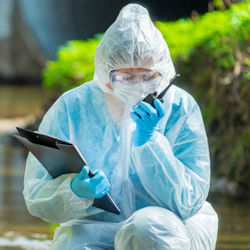Biological Agents
Foodborne Disease: Foodborne illnesses are caused by viruses, bacteria, parasites, toxins, metals, and prions (microscopic protein particles). Symptoms range from mild gastroenteritis to life-threatening neurologic, hepatic, and renal syndromes.
Hantaviruses: Hantaviruses are transmitted to humans from the dried droppings, urine, or saliva of mice and rats. Animal laboratory workers and persons working in infested buildings are at increased risk to this disease.
Legionnaires' Disease: Legionnaire's disease is a bacterial disease commonly associated with water-based aerosols. It is often the result of poorly maintained air conditioning cooling towers and potable water systems.
Molds: Molds are types of fungi that thrive in damp, warm, and humid environments. They grow on a variety of surfaces, including building materials, food, and soil, and reproduce by producing tiny spores that can easily spread through the air, water, or on insects.
When inhaled or touched, these spores can affect human health, especially in individuals who are sensitive or have pre-existing conditions. Exposure may lead to allergic reactions, skin irritation, asthma attacks, and other respiratory problems. Because mold spores are nearly impossible to eliminate completely, controlling moisture and maintaining good air circulation are the most effective ways to reduce mold growth and exposure.
Plague: A severe infectious disease caused by the bacterium Yersinia pestis. It occurs in three main forms: bubonic (affecting lymph nodes), septicemic (spreading in the bloodstream), and pneumonic (affecting the lungs). It is primarily spread to humans through the bite of infected fleas that live on rodents, though it can also spread through direct contact with infected animals or, in rare cases, from person to person through respiratory droplets. Although the plague has been active in the Western U.S., human cases remain quite rare.
Ricin: Ricin is a highly dangerous plant toxin and easily produced natural protein derived from the waste material left after processing castor beans.
It is extremely poisonous and can be lethal even in very small amounts. It works by preventing cells from making the proteins they need to survive, leading to cell death and organ failure. Exposure can occur through swallowing, inhalation, or injection, with symptoms appearing within hours. Signs of ricin poisoning may include difficulty breathing, fever, cough, nausea, vomiting, diarrhea, and severe dehydration, depending on the route of exposure.
Because there is no known antidote, treatment focuses on supportive medical care, such as maintaining breathing and hydration. Its ease of production and high toxicity make ricin a significant concern as a potential bioterrorism agent.
Knowledge Check Choose the best answer for the question.
4-3. Which of the following is one of the most easily produced plant toxins and has been used as a bioterrorist weapon?
You forgot to answer the question!

